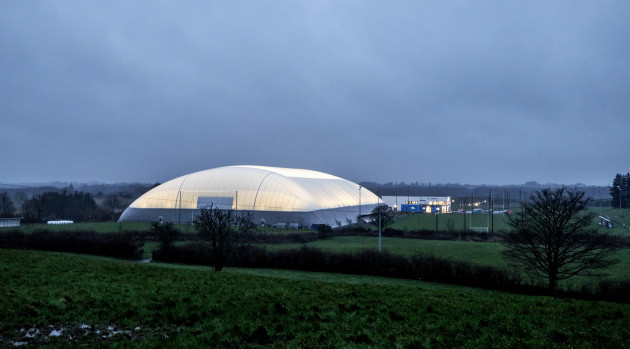WHEN CONNACHT GAA first embarked on a project to build an indoor sports facility at it’s Centre of Excellence in Mayo, they were estimating a cost of about €20 million.
They wanted a venue that would hold football and hurling matches on days when poor weather conditions made other pitches unplayable. Dome grass can’t get waterlogged, and games can be played at summer-time pace.
But the figures looking back at them from the calculations for a steel-frame construction were too high. They needed to find an alternative structure that would be as sturdy as steel, but at a more affordable price.
“The idea came of a dome,” Brendan Heaney, a consultant engineer with Tobin consulting engineers, tells The42 as he takes up the story. Heaney was the project director for what would later become the NUI Galway Connacht GAA Air Dome.
It’s the first of its kind in Ireland, and the largest indoor sports air dome in the world.
Two FBD League games have been played at the venue so far, with the final between Galway and Roscommon taking centre stage in the grand white arena this Friday night.
“We contacted specialists and did some costs,” Heaney continues. “We were coming up with a cost of around €3 million.
“So, we went into Mayo Co council for a revised plan mission and secured that. I must say Mayo Co Council were very helpful all along the process.
“So we secured planning permission and then we went on to tendering it. We appointed a contractor [Prunty Contractors] and as part of that, you had DBS who were the dome specialists and SIS Pitches who were the pitch specialists.
“And we were the project managers and overall design responsibility for the dome, with Connacht being the client.”
Heaney and his company have been associated with Connacht GAA since 2010, when the land at Bekan in Mayo was first purchased for the impressive Centre of Excellence. A vision for this kind of indoor sports facility that would be an antidote to soggy pitches, was in their minds even then.
The first steps towards completing that project were taken in 2018 when they applied for funding. The construction phase got underway in late 2019, although the site was forcibly shutdown just a few months later, due to the Covid-19 pandemic.
Some 10 arctic lorries delivered all the materials that were needed to erect the dome, but it would be 2021 before the dome would be up and ready for use.
“I suppose my main concern was” says Heaney, “when sites closed down, we had 50% of the material delivered to site and the big risk was that something would happen and we wouldn’t get the remaining 50% delivered.
“Our strategy at that point was to keep the deliveries coming, get it all delivered and have the complete dome on site to erect. There was a risk in that and we were nervous about it, but within about two months of the close down, we were able to successfully get all the material delivered to site.
“It’s exactly what we wanted. It’s slightly bigger than Croke Park covered to be honest. The pitch itself is of similar scale to Croke Park but Croke Park would have a three-metre run-off around the pitch, whereas we have a 10-metre run-off and the reason for that is that the dome by nature and shape does taper down at the sides.”
With the Covid pause now behind them, the new dome is now full of air and functional. A few games were played there before Christmas, but it was through the FBD League that wider audiences were able to appreciate the true grandeur of the dome.
The dimensions, according to Heaney, are 150m long and 100m wide. The dome runs up to a height of 26m in the centre, and can easily accommodate the flight of a ball in either football or hurling.
“Having witnessed it and seen it played,” says Heaney, “I have yet to see a ball hit the roof.”
The feedback from players and managers so far has been encouraging too. Speaking after his side’s FBD League game against Sligo, Leitrim boss Andy Moran remarked that the €3.1 million facility was “amazing.”
The opposition manager Tony McEntee was equally enthused, adding that “it does seem to play quick compared to what would be a sodden field outside in bad conditions.”
While spectators are prohibited from attending games at the moment due to the current restrictions, the matches so far suggest that crowds will be treated to high-scoring games when normality resumes.
The Leitrim-Sligo affair produced a 1-21 to 1-17 scoreline. It was similar circumstances in the two semi-finals, as Galway edged out Mayo by 0-17 to 0-13. Likewise, Roscommon defeated Sligo by 3-23 to 0-21.
It’s unlikely that the same games on wet and mucky grass would have had a similar scoring output.
The finalists Galway and Roscommon have both had similar brisk workouts at the dome before squaring off in the decider on Friday.
In addition to playing sport in the building, the dome can also be used to stage concerts and conferences and can safely accommodate a crowd of 10,000 people.
It’s also hosting the GAA Games Development Conference for 2022 on Saturday 19 February and the annual GAA Congress on the weekend of 25-26 February.
As for the future of such air domes in Ireland, Heaney is confident that there is potential to install one in each province. But he also cautions that such structures require constant maintenance and upkeep.
“One thing about the facility is that Connacht’s facility down there is very well managed and they have a full management structure in place.
“In particular relation to a dome, if you have a standard pitch and all you needed was to cut the grass, then the maintenance is low.
“But you look at a dome, there is a lot of maintenance. It has to be checked weekly, monthly, and quarterly for various things. There is a system of generators and a backup generators in the event of high weather but they need to be checked to ensure that all systems are working.
“It can all be controlled from a mobile phone, and there’s a weather station there.
“And there is a cost to erecting the dome. It’s inflated with air and even with the lights inside, there is a cost to keeping it in operation.”
Originally published at 07.30
The42 is on Instagram! Tap the button below on your phone to follow us!



